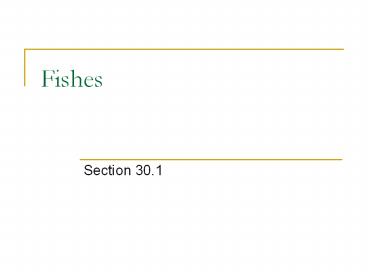Muscular System - PowerPoint PPT Presentation
1 / 22
Title:
Muscular System
Description:
Fishes Section 30.1 Animal Classification Classes of Fishes Superclass Agnatha jawless fish Hagfish feed on dead or dying fishes Lampreys use suckerlike mouths to ... – PowerPoint PPT presentation
Number of Views:106
Avg rating:3.0/5.0
Title: Muscular System
1
Fishes
Section 30.1
2
Animal Classification
Sponges Cnidarians Worms Mollusks Arthropods Echin
oderms
Invertebrates
Animals
Amphibians Reptiles
Fishes
Ectotherms (cold-blooded)
Vertebrates
Phylum Chordata
Birds Mammals
Endotherms (warm-blooded)
3
Classes of Fishes
- Superclass Agnatha jawless fish
- Hagfish feed on dead or dying fishes
- Lampreys use suckerlike mouths to suck out the
preys blood - Skeleton made of cartilage
4
Classes of Fishes
5
Classes of Fishes
- Class Chondrichthyes (kahn DRIHK the ez)
- Cartilaginous fishes
- Sharks, skates and rays
6
Classes of Fishes
- Class Osteichthyes (ahs tee IHK the ez)
- Bony fishes
7
Fishes Breathe Using Gills
- Fishes have gills made up of feathery gill
filaments that contain tiny blood vessels - Oxygen and carbon dioxide are exchanged through
the capillaries in the gill filaments
8
Two-Chambered Hearts
- One chamber receives deoxygenated blood from the
body tissues, and the second chamber pumps blood
directly to the capillaries of the gills
9
Two-Chambered Hearts
- Atrium receiving chamber of the heart
- Ventricle pumping chamber of the heart
10
Sexual Reproduction
- External fertilization is common in most fishes
- Spawning External fertilization in fishes
- Cod can produce as many as 9 million eggs, of
which only a small percentage survive - No parental involvement after spawning
- Cartilaginous fishes undergo internal
fertilization
11
Paired Fins
- Fishes in the class Chondrichthyes and
Ostheichthyes have paired fins - Fins fan-shaped membranes that are used for
balance, swimming, and steering
12
Paired Fins
- Dorsal towards the backbone
- Pectoral chest area
- Pelvic hip area
- Anal
- Caudal - tail
13
Developed Sensory Systems
- Lateral line system a line of fluid-filled
canals running along the sides of a fish that
enable it to detect movement and vibrations in
the water - Found in cartilaginous and bony fishes
14
Developed Sensory Systems
- Fishes have eyes
- Some fishes that live areas absent of light may
have reduced, almost non-functional eyes
Blind cave fish (small, non-functioning eyes)
15
Developed Sensory Systems
- Some fishes have an extremely sensitive sense of
smell - Sharks can follow a trail of blood through the
water for 300 feet
16
Scales
- Scales thin bony plates formed from the skin
- Scales can be toothlike, diamond-shaped,
cone-shaped, or round
17
Scales
- Shark scales are similar to teeth found in other
vertebrates
18
Jaws
- The advantage of jaws is that they enable an
animal to grasp and crush its prey with great
force
19
Jaws
- Sharks have up to 20 rows of teeth that are
continually replaced (e.g. vending machine) - Their teeth point backwards to prevent prey from
escaping once caught
20
Vertebrae Provides Flexibility
- Separate vertebrae are important for fish
locomotion which involves continuous flexing of
the backbone
21
Swim Bladder
- Swim bladder a thin-walled, internal sac found
just below the backbone in most bony fishes - A swim bladder controls a fishs depth by
regulating the amount of gas in the bladder
22
Swim Bladder
- Some fishes remove gases through a special duct
that attaches the swim bladder to the esophagus - Sharks dont have swim bladders
- Sharks maintain their buoyancy via fatty livers































